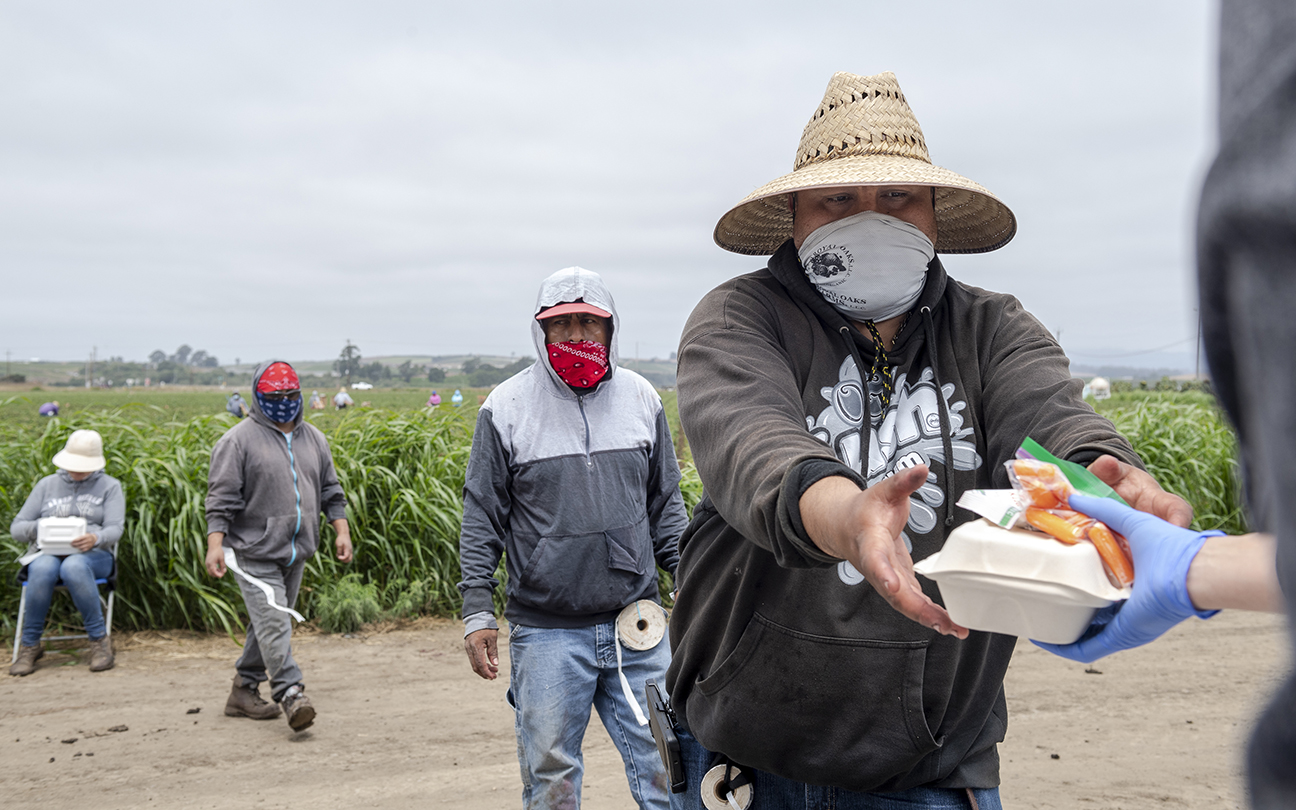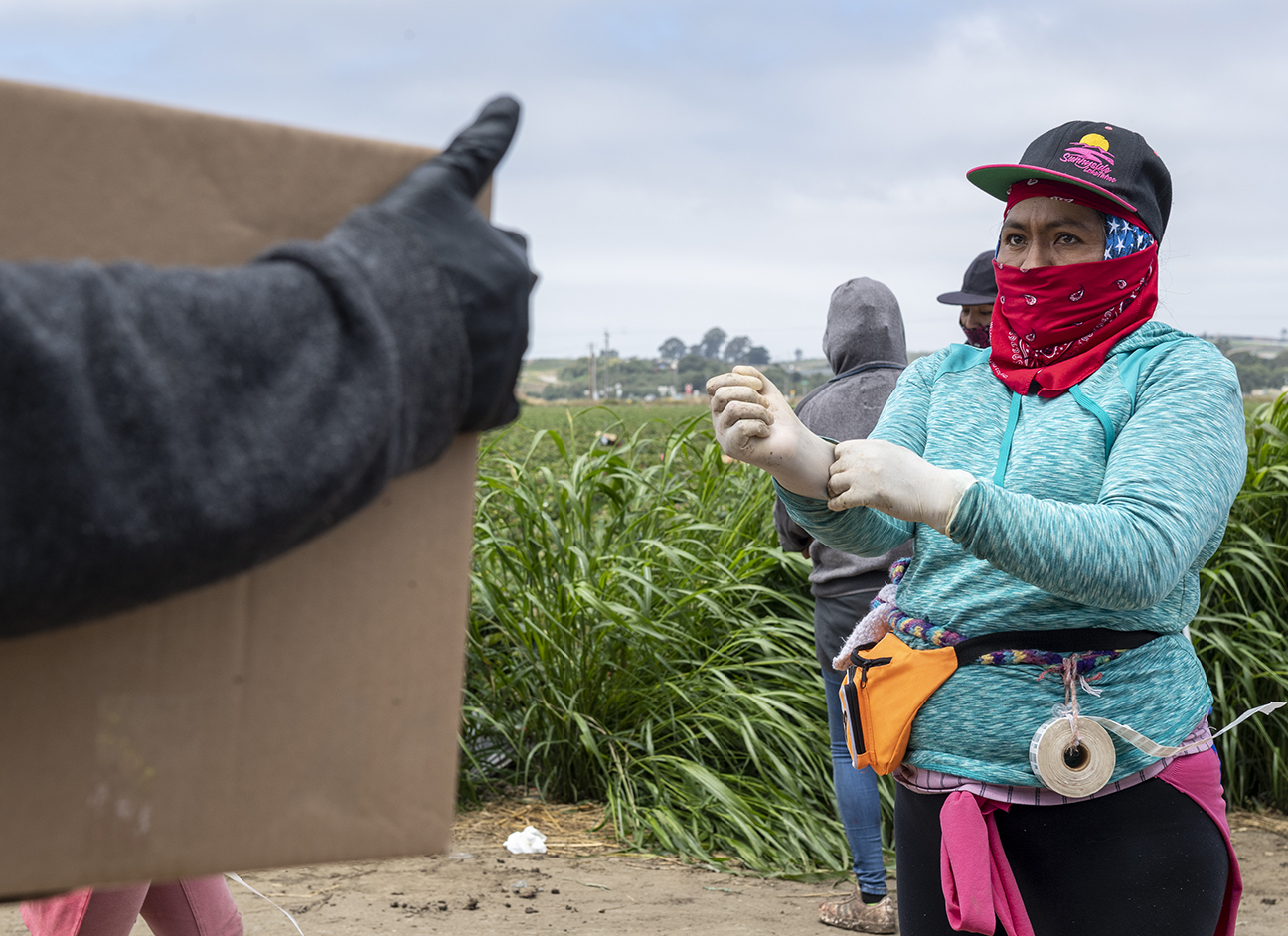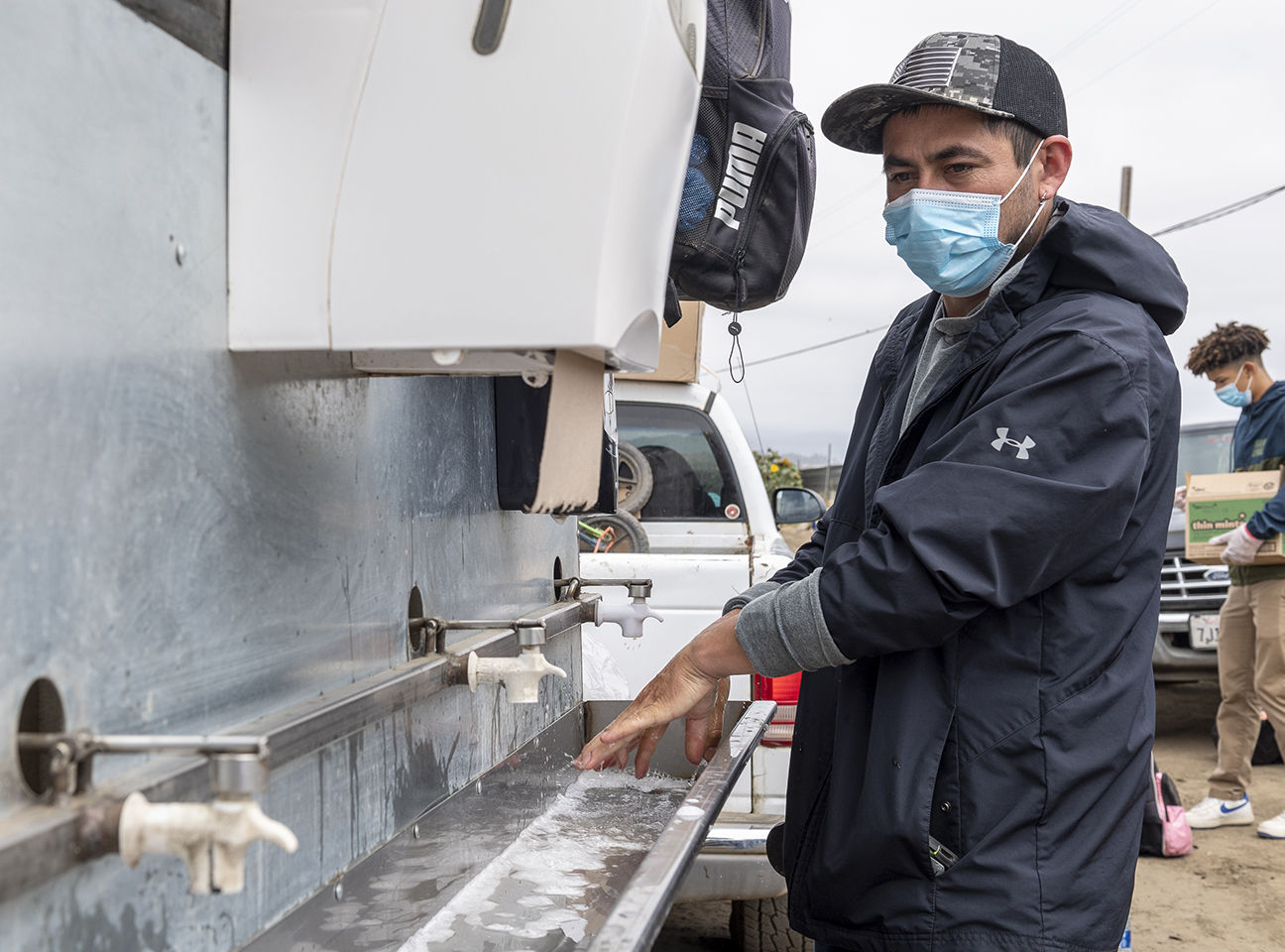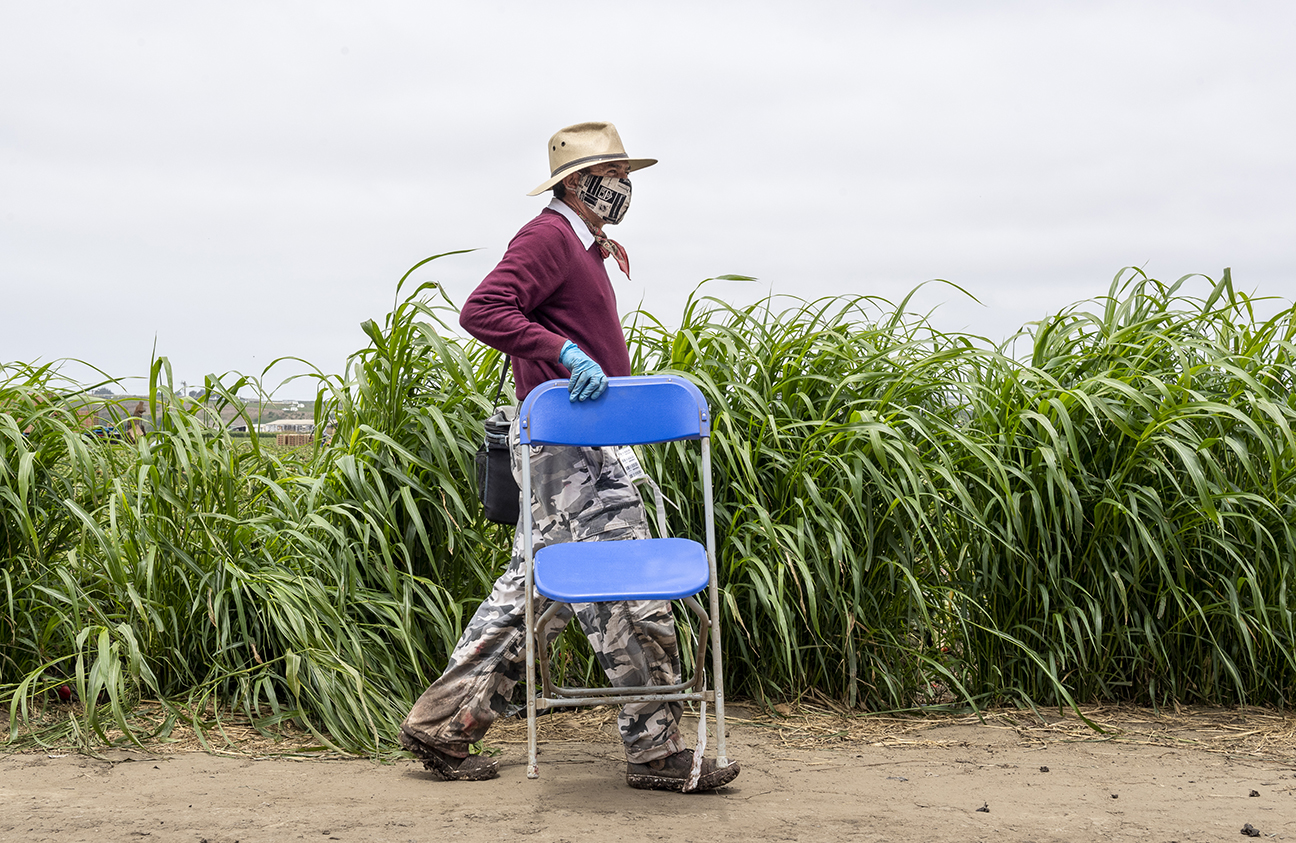Two farmworkers sit at a socially acceptable distance to eat their lunch as a wave of farmworkers make their way to receive their free lunch and COVID-19 safety tips by the Campesino Appreciation Caravan in Watsonville, Calif., on Friday, Aug. 7, 2020. The caravan is made up of community educators, families and young adults who have been coming to multiple fields in Watsonville to show their appreciation to the farmworkers since the middle of March. | Photo by David Rodriguez for the Salinas Californian
| FEATURED
Story by Jessica M. Pasko
Photos by David Rodriguez for the Salinas Californian
Eleazar Sosa, a vineyard manager in Greenfield, oversees a crew of about 20 who monitor the vines for disease, control irrigation and harvest the wine grapes in late summer. This year, he and his coworkers are also confronting a new challenge: the growing threat of coronavirus.
Formal programs are in place to slow the spread of COVID-19 among agricultural workers. But for now, Sosa and his crew are embracing a more direct, community approach to skirt the virus.
In Monterey County, agriculture workers such as field laborers and those working in packing and processing facilities are three times more likely to be infected with coronavirus than employees in the county’s other industries, according to the California Institute for Rural Studies.
Many of these essential workers also lack critical social safety net supports such as health insurance and affordable housing. More than half of agriculture workers surveyed about health care issues by the institute recently reported the double-punch of no sick leave and no insurance. For those who are insured, the high cost of prescriptions, copays and deductibles present additional barriers.
Sosa knows he is lucky. He and his wife live by themselves, their four kids grown and out of the house. They stay home when not working and limit their trips to just the essentials, like grocery shopping. But he worries about others in his community of Greenfield, particularly those living in crowded quarters or working in indoor produce processing and packing facilities, where social distancing is more difficult. Some employers provide basic, dormitory-style housing; other workers share motel rooms or small apartments with as many as two to three other families.
To help, community organizations have launched COVID-19 education programs throughout the Central Coast. In southern Santa Cruz County, the Watsonville Campesino Appreciation Caravan, a group of local residents, regularly delivers food, masks and other supplies to workers. And in Monterey County, the Grower-Shipper Association (GSA), an industry trade organization, has been working with local hospitals to bring medical professionals directly into the fields.
Abby Taylor-Silva, a spokeswoman with GSA, said the organization knew right away that they had to take action to protect agriculture workers.
Enlarge

“In mid-March, when shelter-in-place orders came forward, we worked with Monterey County officials to put together guidance (for agriculture employers) and issue an advisory,” said Taylor-Silva. “It was really important for us to do this, above and beyond just calling the county” for help.
Soon after, resident physicians and nurses from Natividad Medical Center began visiting local farms and packing facilities to disperse masks and provide training on social distancing in the home and workplace. So far, they’ve reached around 5,000 workers. Outreach is conducted in English, Spanish and three indigenous languages: Mixteco, Zapoteca and Triqi.
SIDEBAR: Public Service Announcements
They also talk about what to do if a family member gets sick and how to get help. GSA has reserved a bank of local hotel rooms for those workers who need to be quarantined. About 150 workers have stayed in those rooms so far. Strict cleaning is provided by companies hired by GSA, and meals and visits come from Salinas Valley Memorial Hospital health care workers.
This part of the program has been so successful that it’s now being replicated by the state through Housing for Harvest.
Dr. Erika Romero said they also make time to speak directly with workers about their experiences and serve as a type of intermediary between them and their bosses.
Enlarge

“It’s very difficult for us to just go in and say, ‘Hey, these are some of the things your entire company should do,’” said Romero, a second-year resident physician at Natividad Medical Center. “What we want to say is, ‘You’ve been working here every day, what are some of the things you think could be changed in your specific working conditions?’”
From there, Romero and her colleagues take that feedback and have conversations with employers and managers to help facilitate some of these changes, including ensuring that social distancing is followed on the buses some farms use to transport workers to the field. In addition to providing information on social distancing and wearing masks, they also provide information on where to sign up for food stamps, how to apply for unemployment insurance and ways to get mental health resources, said Romero.
SIDEBAR: Essential Worker Cards
An estimated 90,000 to 100,000 agriculture workers populate the tri-county region of Monterey, Santa Cruz and San Benito counties during peak season, plus their families. Not only do they face this greater risk of contracting coronavirus, but there’s also a high likelihood they are undocumented. According to the Center for Farmworker Families, up to 75 percent of California’s farmworkers are undocumented. Given this, many employees don’t feel comfortable taking sick time even when they’re entitled to it, for fear of potential retribution or economic loss.
“Our workers are petrified,” said Armando Elenes, secretary-treasurer of United Farm Workers, the nation’s largest farm workers’ union. “The fears we have had are coming true.”
Getting employers to actually adhere to regulations and provide paid time off for sickness is a significant challenge, said Elenes. From the start of the pandemic, UFW sent out letters to employers demanding they take steps to protect workers, including providing sick leave and training around COVID safety, said Elenes.
The passage of the federal Coronavirus Aid, Relief and Economic Security Act, better known as the CARES Act, was a big step, said Elenes. It requires employers with 500 or fewer employees to provide up to two weeks’ sick leave for employees unable to work due to COVID-19.
Enlarge

In California, Gov. Gavin Newsom has extended those same protections to employers with 500 or more employees. The UFW also got the California Division of Occupational Safety and Health to issue specific COVID-19 guidance for agriculture employers, including regularly screening employees for symptoms and notifying health officials when a worker is diagnosed with the virus. However, Elenas said not all companies are following the recommendations and paid sick leave requirements.
“Now we’re fighting to actually get (these measures) implemented,” said Elenes. “Wage theft is rampant in this industry.”
Wage theft, according to the union, doesn’t just mean not paying for time worked; it also means withholding sick time. Elenes said he hears from as many as five employees a day reporting they aren’t getting paid time off when they need to quarantine, or that they aren’t being notified when coworkers test positive. Employers are often doing the “bare minimum,” he said.
And that means employees may go to work sick, because they are stuck between a rock and a hard place. They need to feed their families and pay their rent — even as cases climb.
Enlarge

“It’s going to get uglier,” he said.
That’s what Assemblyman Robert Rivas is afraid of, too. The Democrat from Hollister introduced a first-in-the-nation COVID-19 farmworker relief bill aimed at protecting the health, safety and economic security of California’s agriculture workers.
SIDEBAR: About the California COVID-19 Farmworker Relief Package
The bill, currently winding its way through the state Legislature, includes efforts to incentivize the development of permanent, safe housing for agriculture workers. It’s an issue close to Rivas’ heart; he grew up locally living in migrant farmworker housing with his family.
“We must take steps to alleviate the overcrowded housing conditions that leave farmworkers and their families constantly at risk,” said Rivas. “Once one member of these cramped households becomes infected or exposed, it is too late.”
This package was produced as part of the COVID-19 Information Hub at LocalNewsMatters.org. The Info Hub is a collaborative project supported by JSK Fellowship Program at Stanford University. The story is by Jessica Pasko for Bay City News Foundation; the photos are by David Rodriguez for the Salinas Californian; the audio and overall package is edited by Krista Almanzan, a Senior Journalism Fellow at JSK.
Have something to say about this story? Send us a letter.
